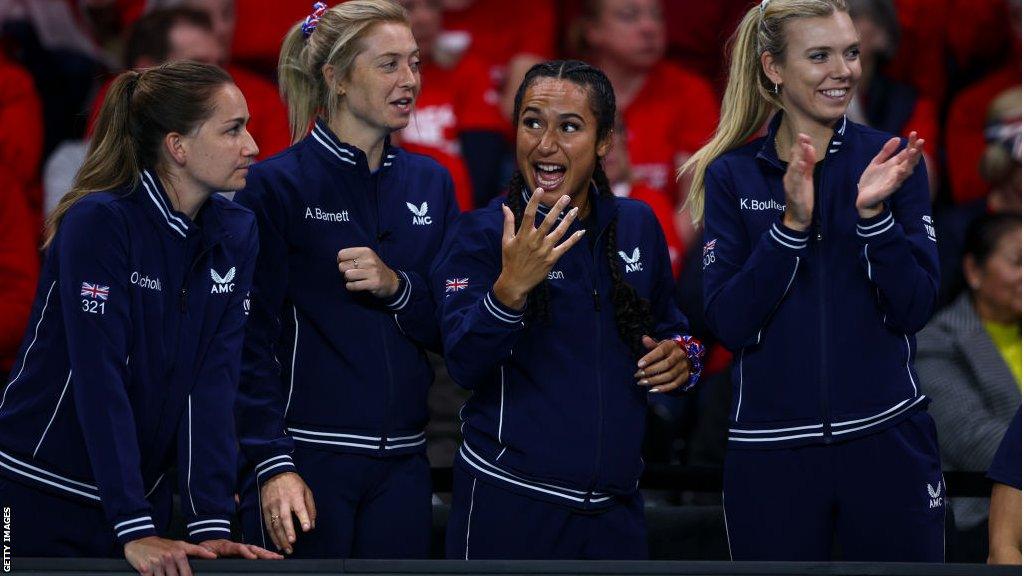'Grand Slam tennis nation like Britain should have far more top-100 players'
- Published

Great Britain, who have won only two of their past seven Billie Jean King Cup ties, faced France last weekend with no top-100 singles players
Great Britain have never won the Billie Jean King Cup, despite playing every single year since the women's team competition began in 1963.
That they did not win this year is no surprise at all.
Harriet Dart and Katie Boulter played some excellent tennis in Coventry last weekend, but a team fielding singles players with rankings of 138 and 154 was never likely to prosper against a side of France's quality - and this was only the qualifying round for the 12-team Finals.
There was admittedly no Emma Raducanu - who is currently 68 in the rankings but will forever be a Grand Slam champion.
What she achieved in New York in September 2021 was so spectacular that it has the potential to drive interest in the sport for at least a decade. She is, though, Britain's only female top-100 singles player, and there are no doubles players anywhere inside the world's top 50.
The numbers are healthier on the men's side in both singles and doubles, and British tennis has hit the ultimate high on multiple occasions in recent years.
In the past eight years, there have been British Grand Slam champions in the women's singles, men's singles, men's doubles, mixed doubles and each of the wheelchair events.
But there is no escaping the feeling that a Grand Slam nation like Britain should have far more top 100 players, especially on the women's side.
"Being a Grand Slam nation is not a passport to automatic success," Lawn Tennis Association (LTA) chief executive Scott Lloyd said in Coventry at the weekend.
"The depth of international competition now is greater than it has ever been historically, I think.
"But here in Britain, our competitive set is football, rugby, cricket: it isn't actually necessarily the tennis association in the Czech Republic.
"We have to get young players playing tennis rather than football, rugby, cricket and other things that they have huge wealth of opportunity to access. So the funds available to the LTA relative to the funds available to another tennis association somewhere else isn't always the immediate comparison."
The LTA received £42.43m in funding from Wimbledon last year. There are a total of five British men and women in the world's top 100, and if we are to compare the UK with the other Grand Slam nations, then Australia has eight, France has 14 (but no Grand Slam singles champion for nearly a decade) and the United States 28.
What is the LTA doing to try to drive up that number?
At the bottom of the pyramid, there is the investment in public tennis courts - to try to encourage you and me to play more often.
Helped by government investment of £22m, and £8.5m of the LTA's own money, Lloyd says he expects about 2,000 courts - which were considered either unplayable or in very poor condition - will be brought back to life.
And at the top of the pyramid, on the development side, are the national academies - although from next summer, two academies will become one.
Stirling has encountered many problems in its first four years, and so in future all efforts will be focused on Loughborough.
Loughborough is currently home to two of the British girls in the top 30 of the junior world rankings: 17-year-old Ranah Stoiber, who reached the semi-finals of the Australian Open girls' singles in January, and 15-year-old Mimi Xu.
From September 2024 Loughborough's numbers will double, to anything up to 24. The LTA say this will ensure the best players are always surrounded by the best coaches, and will always have the best players to spar with. But with a higher volume of players comes the risk that the quality of the service provided will be diluted.
The LTA accepts it needs more players, and also more coaches.
"The coaching cohort in Great Britain, in my view, is exactly like the playing cohort," the LTA's performance director Michael Bourne said.
"Our best coaches are world class - they can impact the development of these players to a high, high level. But as we've said we need a volume and as our volume of players gets higher, our volume of coaches also needs to get higher.
"We've got women coming through. I wouldn't say we've got a good number. We have female-specific performance coach development courses which includes some mentoring from coaches who have been able to make it further through the pathway.
"Some of the barriers we are seeing with our female coaches - it's not their coaching level - it's some of the barriers that are in the environment around them, or their knowledge of how to navigate them. Not having enough knowledge in terms of how to get into roles; perceptions a female coach may have going into a male-dominated environment."
And then there is the question of fitness. Both Emma Raducanu and Jack Draper have had many physical issues in the early years of their career, while Katie Swan's and Katie Boulter's problems have followed them into their mid-20s.
Former world number one Ashleigh Barty's strength and conditioning coach Mark Taylor joined the LTA as the head of performance, science and medicine in January, and it was interesting to hear Bourne say he is currently looking to appoint someone to work specifically on the physical development of junior players.
He added: "It's not in response to [recent problems] directly. It's something that we've always focused on that we know we needed to elevate. And yes, we do recognise that some of our top talents haven't been able to stay on the training court and match court as much as they would have liked.
"It's something we want to focus our attention on, because we know we have got the talent."

Unmasking the forgotten assailants: Examine the seven men who attempted to kill Queen Victoria
Who is the greatest football pundit of all time? Match of the Day Top 10 ranks the best analysts

